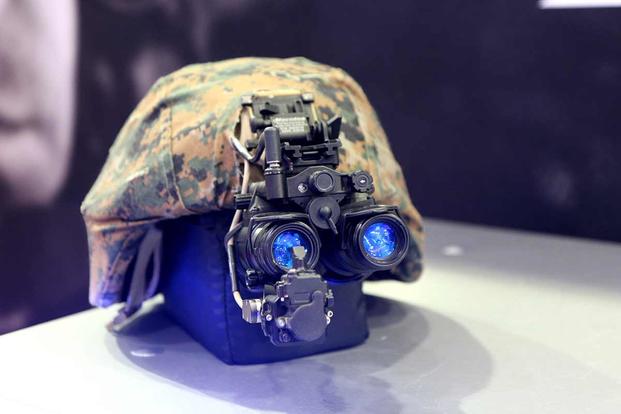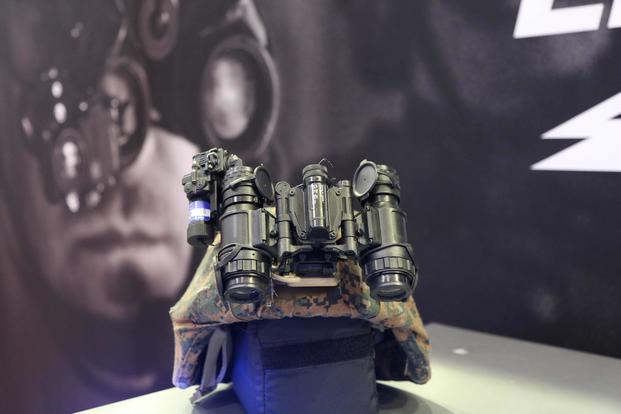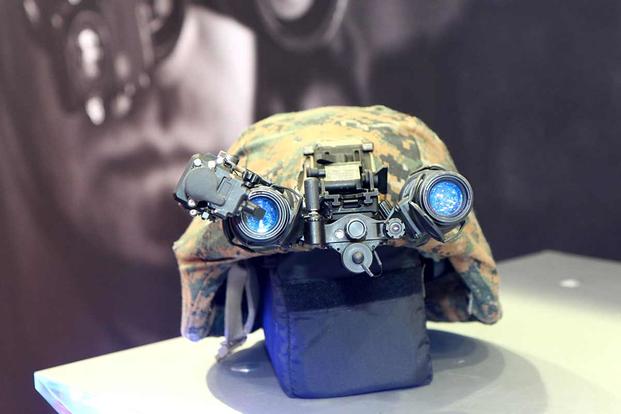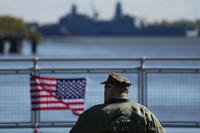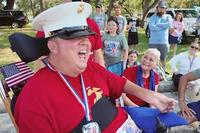Marines will soon receive new, binocular-style night-vision goggles, but service officials say they are still interested in an advanced wireless system the U.S. Army is about to start fielding.
The new Squad Binocular Night Vision Goggles (SBNVG) emerged from an effort that began last year with Marine infantry units testing 1,300 of the venerable AN/PVS 31A dual-tubed NVGs used by U.S. special operations forces.
"We went to that because it was a tested product by their community, so we knew the level of capability had already been evaluated," Justin Govar, an engineer with Program Manager Infantry Weapons at Marine Corps Systems Command, told Military.com.
Marines who tested the 31As, equipped with a special, clip-on thermal device, found that they performed significantly better than the outdated AN/PVS 14 monocular NVGs.
Related: Marines Select New Night-Vision Binoculars for Grunts
"All the feedback we received from the operating forces was positive; the Marines loved the system, the additional capability," said Roberto Gonzalez, combat optics lead for PM Infantry Weapons, describing the system's increased depth perception.
The Marine Corps recently awarded a $250 million contract to Harris Night Vision to make the new SBNVG, which offers enhanced capabilities over the current AN.PVS 31A, Marine officials said. Harris Night Vision has since been acquired by Elbit Systems of America.
The contract award was designed to get binocular-style NVGs equipped with thermal capability into the field as quickly as possible while Marine equipment officials evaluate the Army's Enhanced Night Vision Goggle-Binocular effort, which could offer an even greater capability, Marine officials said.
"So, while we are doing the current program, we are still participating in tracking the ENVG-B," Govar said. "What we are doing, is we are fielding capability now and once ENVG-B ... gets to the level that fits what the Marine Corps needs in our program, we will make the decision when to transition."
The new Squad Binocular Night Vision Goggles feature several improvements over the 31A, he said.
"It is not the 31A," Govar said. "The performance specification was written to provide the Marine Corps with a similar level of performance capability but ... we had objectives to get above and beyond what the current system offers."
The SBNVG features a variable diopter, which allows for "vision adjustment for the user," he said.
The 31A has a fixed diopter, so "if you had poor vision, you would have to put in a different diopter lens," Govar added.
The system features an Enhanced Clip-On Thermal Imager (ECOTI), made by Safran Optics 1, that allows the user to see a heat signature through smoke and other obscurants, said John Ennis, business development manager, Defense Department night vision programs for Elbit Systems of America-Night Vision.
The Marine Corps requested that SBNVG feature an infrared illuminator for use in subterranean and other environments where traditional IR is unable to gather and amplify ambient light, Ennis said.
"When you are in a subterranean environment ... there is no ambient light at all," he said. "So, an integrated IR illuminator gives you that flash light that only night vision can see."
There is also a "high-light shutoff, so if you are in a super bright environment, it will automatically shut off the goggles, so it doesn't burn out the tubes," Ennis said.
The SBNVGs feature the traditional flip-up stowing mechanism, but Marines also wanted a "side-stow" capability for operating in areas with low ceilings where they could be snagged, he said.
"When you do a side-stow, it automatically shuts off the tubes," Ennis said, adding that Marines can use one tube at a time if they need to the other eye for other tasks such as looking through a rifle optic.
For now, the Marine Corps is planning to buy about 14,000 of new SBNVGs, but the service has a total NVG requirement of about 37,500, officials said.
Marine officials added that the service is very interested in the Army's Enhanced Night Vision Goggle-Binocular effort. The Army is preparing to field its new ENVG-Bs to soldiers from the 1st Infantry Division's 2nd Armored Brigade Combat Team at Fort Riley, Kansas.
The ENVG-B features a fused thermal imager and can wirelessly connect to the Family of Weapon Sight-Individual (FWS-I), displaying the weapon sight reticle in the ENVG-B, arming soldiers with the ability to accurately engage without shouldering the weapon, Army officials said.
"ENVG-B brings a lot more capability than the SBNVG," Gonzalez said, pointing to the system's wireless capability.
The Marines will continue to observe and gather data that comes from soldiers using the system in a real-world environment, he added.
The Corps has also ordered 195 ENVG-Bs for further evaluation, Govar said.
"Once we receive these systems, we will then do our evaluation with our users to see how it fits within the operating force and how it performs," he said. "There are a lot of capabilities the ENVG-B brings, but the Marine Corps hasn't yet folded in how we are going to be able to utilize all those capabilities with our overall [capability sets] that we provide. We still have to figure that out."
Govar added that the timeline for ENVG-B testing has not been determined.
"Depending on the timelines of how the Army's program works out, when we get our systems, when we can get that evaluation done -- all those events will drive that timeline," he said.
-- Matthew Cox can be reached at matthew.cox@military.com.
Read more: Hundreds of Marines Are Headed to Central, South America as Amphib Changes Homeports
